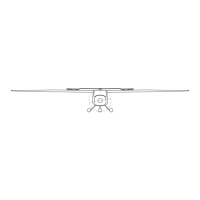Engine re in ight
1. Shut both fuel valves and set magnetos to OFF.
2. Set full power (throttle lever in full forward position).
3. Disconnect the battery from the circuit (pull battery disc. ring on the switch column)
3b. Keep avionics ON and master ON as required, on approach set both OFF.
4. Set ventilation for adequate breathing. Keep in mind that oxygen intensies re.
5. Perform side-slip (crab) manoeuvre in direction opposite the re.
6. Perform emergency landing out procedure.
Smoke in cockpit
Smoke in cockpit is usually a consequence of electrical wiring malfunction. As it is most denitely
caused by a short circuit it is required that the pilot reacts as follows:
1. Master switch to I (key in central position). This enables unobstructed engine operation while
at the same time disconnects all other electrical devices from the circuit. Verify that the 12 V and
optional Pitot heat are OFF as well.
2. Disconnect the battery from the circuit (pull battery disconnection ring on the instrument
panel’s switch column).
3. Land as soon as possible.
In case you have trouble breathing or the visibility out of the cockpit has degraded severely due to
the smoke, open the cabin door and leave it hanging freely. Flying with the door open, do not, under
any circumstances exceed 60 kts (110 km/h).
Carburetor icing
First noticeable signs of carburetor icing are rough engine running and gradual loss of power.
Carburetor icing may occur even at temperatures as high as 50°F (10°C) , provided the air humidity is
increased.
The carburetor air-intake in the Sinus 912 LSA is preheated, running over the water cooling radiator
before entering the carburetors. Therefore the possibility of carburetor icing is minuet.
Should you be suspecting carburetor icing to take place, descend immediately into warmer and/
or less humid air!
In case of complete power loss perform emergency landing procedure.
Electrical system failure
The engine will continue to function due to the onboard alternator and battery. In case of bat-
tery failure, be aware that the engine can keep running, however a re-start will not be possible.
In event of alternator failure, the battery will support the onboard avionics. In event of double
power source failure, use analogue on-board instruments and land normally.
3-4
Emergency procedures

